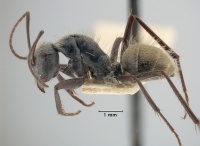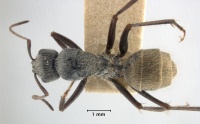Camponotus bigenus
| Camponotus bigenus | |
|---|---|

| |
| Scientific classification | |
| Kingdom: | Animalia |
| Phylum: | Arthropoda |
| Class: | Insecta |
| Order: | Hymenoptera |
| Family: | Formicidae |
| Subfamily: | Formicinae |
| Tribe: | Camponotini |
| Genus: | Camponotus |
| Species: | C. bigenus |
| Binomial name | |
| Camponotus bigenus Santschi, 1919 | |
Identification
Keys including this Species
Distribution
Latitudinal Distribution Pattern
Latitudinal Range: -30.75° to -30.75°.
| North Temperate |
North Subtropical |
Tropical | South Subtropical |
South Temperate |
- Source: AntMaps
Distribution based on Regional Taxon Lists
Australasian Region: Australia (type locality).
Distribution based on AntMaps
Distribution based on AntWeb specimens
Check data from AntWeb
Countries Occupied
| Number of countries occupied by this species based on AntWiki Regional Taxon Lists. In general, fewer countries occupied indicates a narrower range, while more countries indicates a more widespread species. |

|
Estimated Abundance
| Relative abundance based on number of AntMaps records per species (this species within the purple bar). Fewer records (to the left) indicates a less abundant/encountered species while more records (to the right) indicates more abundant/encountered species. |

|
Biology
Castes
Nomenclature
The following information is derived from Barry Bolton's Online Catalogue of the Ants of the World.
- bigenus. Camponotus (Myrmocamelus) bigenus Santschi, 1919a: 333 (s.w.m.) AUSTRALIA (Queensland).
- Type-material: 1 syntype major worker, 3 syntype minor workers, 1 syntype male.
- Type-locality: Australia: Queensland, Townsville (F.P. Dodd).
- Type-depository: NHMB.
- Combination in C. (Myrmophyma): Emery, 1925b: 110; Santschi, 1928e: 481.
- Status as species: Emery, 1925b: 110; Taylor & Brown, 1985: 110; Taylor, 1987a: 11; Bolton, 1995b: 89; McArthur, 2014: 98.
- Distribution: Australia.
Type Material
- Camponotus (Myrmocamelus) bigenus Santschi, 1919: Syntype, 4 workers, 1 queen, 1 male, Townsville, Queensland, Australia, Museum of Comparative Zoology.
- Camponotus (Myrmocamelus) bigenus Santschi, 1919: Syntype, 1 worker, Townsville, Queensland, Australia, Museum Victoria, Melbourne.
- Camponotus (Myrmocamelus) bigenus Santschi, 1919: Syntype, 1 worker, Townsville, Queensland, Australia, South Australian Museum.
Unless otherwise noted the text for the remainder of this section is reported from the publication that includes the original description.
Description
Worker major. Length 10mm. Red. Clypeus and mandibles darker red. Around the thorasic sutures and on top of the epinotum more brownish. Node and appendages dark red brown. Gaster black rimmed with yellow. Sculpture similar to pellax but the thorax is even richer in pits. Pilosity erect more abundant and longer than pellax. Head 3.2mm long, 2.9 mm wide, in other respects like pellax and capito Mayr. Clypeus flat with a moderate indentation at the border of feebly produced lobe. The frontal ridges reach the median occellus. Lateral occelli obsolete. Scape reaches occipital border. Thorax is 3.3mm long, shorter and more squat than pellax. Mesonotum wider than long and slightly raised towards the pronotal suture. Metanotum tends lower at the back, on the same level as the basal face of the epinotum (= propodeum), this latter being scarcely 1/4 longer than the declivity but forming a very rounded angle. The node is much wider than high, its sides narrow but blunt, form at the summit and at each side a rounded angle. Anterior face convex, posterior face flat. Viewed from the top the length is about 2.5 times the width.
Worker Length 6.8-8.7mm. Black, condyle and scape ferruginous. Matte, densely and finely reticulate, front of head more strongly,gaster more finely than the thorax. Pilosity erect, white, long pointed abundant (40 to 60 on the thorax), richer on the gaster, poorer on the head. Long pubescence, yellow grey or pale gold, very abundant and close, not hiding the sculpture of the thorax but it does hide that of the gaster and almost the clypeus. Head rectangular, very much longer than wide, sides almost straight converging slightly in front. Posterior border and vertex convex. Eyes at the posterior quarter. Clypeus feebly keeled, anterior border crenulated. Frontal ridges slightly diverging. Mandibles finely punctate and strongly rugose, the external border is straight, armed with 7 or 8 teeth. Thorax is much shorter and more convex compared with pellax. The convex pronotum is strongly inclined at the front. The mesonotum is convex, not raised towards the pronotal suture which is strong. Metanotal suture is obsolete. The basal face of the epinotum straight or weakly concave passing through a wide curve to the declivity 1/2 to 1/4 shorter. Node, thicker than the height of its flat anterior surface and less than the posterior face which is vertical and convex from right to left. The summit is strongly rounded and projects forward a little.
Male 7.5mm long.
References
- Bolton, B. 1995b. A new general catalogue of the ants of the world. Cambridge, Mass.: Harvard University Press, 504 pp. (page 89, catalogue)
- Emery, C. 1925d. Hymenoptera. Fam. Formicidae. Subfam. Formicinae. Genera Insectorum 183: 1-302 (page 110, combination in C. (Myrmophyma))
- Heterick, B.E. 2021. A guide to the ants of Western Australia. Part I: Systematics. Records of the Western Australian Museum, Supplement 86, 1-245 (doi:10.18195/issn.0313-122x.86.2021.001-245).
- Heterick, B.E. 2022. A guide to the ants of Western Australia. Part II: Distribution and biology. Records of the Western Australian Museum, supplement 86: 247-510 (doi:10.18195/issn.0313-122x.86.2022.247-510).
- Santschi, F. 1919a. Cinq notes myrmécologiques. Bull. Soc. Vaudoise Sci. Nat. 52: 325-350 (page 333, soldier, worker, male)
- Santschi, F. 1928e. Nouvelles fourmis d'Australie. Bull. Soc. Vaudoise Sci. Nat. 56: 465-483 (page 481, combination in C. (Myrmophyma))

